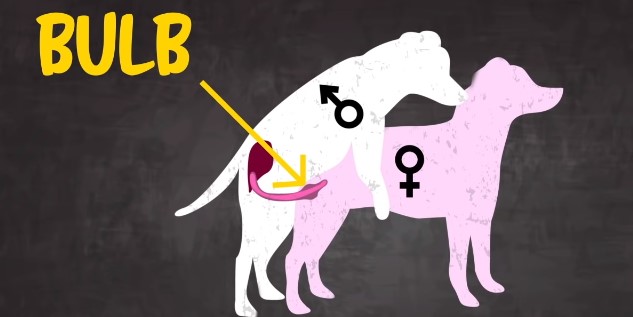If they are mating, will my dog get pregnant if they were stuck? This question is very important for a dog owner. When dogs get stuck during mating, it is known as a tie or a “copulatory lock.”
This occurs when the male’s penis swells inside the female’s vagina, creating a tight fit that prevents them from separating. The purpose of this mechanism is to ensure successful insemination by allowing the sperm to travel deep into the female’s reproductive tract.
The duration of a tie can vary depending on several factors, including breed and individual dogs. On average, it lasts around 15-30 minutes but can sometimes extend up to an hour or more. During this time, both dogs may appear anxious or uncomfortable, and they may try to separate by pulling in opposite directions.
It is important for dog owners not to panic if their pets get stuck during mating. Attempting to forcibly separate them could cause injury and should be avoided. Instead, it is best to provide a calm environment and allow nature to take its course.
After the tie naturally ends, both dogs will usually rest for a while before going about their normal activities again without any issues arising from getting stuck together during mating.
Understanding Canine Reproduction
Canine reproduction is a complex process that involves both male and female dogs. It begins with the female’s heat cycle, during which she becomes receptive to mating.
This typically occurs every six to twelve months, depending on the breed and individual dog. Male dogs are attracted to females in heat by their scent, and they engage in mounting behavior as part of the mating process.
During mating, the male dog’s penis swells inside the female’s vagina, forming a “tie” or “knot.” This tie serves an important purpose – it ensures that sperm is delivered directly into the reproductive tract of the female. The duration of this tie can vary from several minutes to over an hour.
After successful mating, fertilization takes place within the female dog’s reproductive system. The eggs released by her ovaries are then fertilized by sperm cells from the male dog. These fertilized eggs travel down into her uterus where they implant themselves onto its walls. This marks the beginning of pregnancy.
Understanding canine reproduction is crucial for responsible pet owners who may be considering breeding their dogs or simply want to ensure proper care for their pets’ health needs.
By familiarizing oneself with these processes and recognizing signs of successful mating and pregnancy, owners can provide appropriate care throughout each stage of reproduction without any complications arising later on.
The Importance of Timing in Canine Mating
Timing plays a crucial role in canine mating. It is essential to understand the reproductive cycle of female dogs and the optimal time for breeding in order to increase the chances of successful pregnancy.
Female dogs have a limited window of fertility, known as their estrus or heat period, which typically occurs every six to twelve months. During this time, they release eggs and are receptive to mating.
Determining the exact timing of ovulation is key in maximizing the likelihood of successful fertilization. While some signs can indicate that a female dog is ready for mating, such as swelling of the vulva and changes in behavior, these are not always reliable indicators of ovulation.
Therefore, it is recommended to use additional methods like vaginal cytology or hormone testing to pinpoint the optimal time for breeding.
Breeding too early or too late during a female dog’s heat period can significantly reduce the chances of pregnancy. If mating occurs before ovulation has taken place, there will be no viable eggs available for fertilization.
On the other hand, if mating happens after ovulation has already occurred and sperm cells have died off, conception becomes unlikely as well. Thus, precise timing is critical when attempting to breed dogs successfully.
By understanding and respecting the importance of timing in canine mating, breeders can greatly increase their chances of achieving successful pregnancies.
Accurate identification of a female dog’s fertile period through various methods allows breeders to ensure that matings occur at precisely the right moment for optimal results.
This attention to detail ultimately contributes to maintaining healthy breeding programs and producing strong litters with desirable traits.
Factors That Affect the Chances of Pregnancy

Certain factors can significantly affect the chances of pregnancy in dogs. One important factor is the timing of mating. Female dogs are only fertile for a specific period during their heat cycle, which typically occurs every six to twelve months.
It is crucial to mate the female dog at the right time, usually when she is in estrus or “in heat,” as this increases the likelihood of successful fertilization.
Another factor that affects pregnancy chances is the age and health condition of both male and female dogs involved.
Older dogs may have reduced fertility rates compared to younger ones, while certain health conditions like infections or hormonal imbalances can also impact reproductive capabilities.
Therefore, it’s essential to ensure that both potential parents are healthy and free from any underlying medical issues before attempting mating.
The breed of the dogs can also play a role in determining pregnancy success rates. Some breeds may be more prone to reproductive problems than others due to genetic predispositions or physical characteristics.
For example, brachycephalic breeds with shortened snouts (such as Bulldogs or Pugs) often face difficulties during natural breeding due to their anatomy.
In such cases, artificial insemination might be recommended by a veterinarian to increase the chances of conception.
Understanding these factors that affect canine pregnancy can help breeders make informed decisions when planning matings between dogs.
By considering timing, age and health conditions, as well as breed-specific considerations, breeders can maximize their chances of achieving successful pregnancies and ultimately producing healthy litters.
Signs of a Successful Mating
When it comes to determining whether a mating between two dogs was successful, there are several key signs to look out for. One of the most obvious indications is when the male dog successfully mounts the female and achieves intromission, or penetration.
This allows for the transfer of semen into the female’s reproductive tract, increasing the chances of fertilization.
Another important sign is known as “tying,” which refers to when the male dog’s penis swells inside the female’s vagina during mating.
This creates a physical connection between them that can last anywhere from a few minutes to over an hour. Tying helps ensure that sperm remains in close proximity to the eggs, increasing the likelihood of successful fertilization.
In addition to these physical signs, behavioral cues can also indicate a successful mating. Both male and female dogs may exhibit increased interest in one another during this time, with heightened sniffing and licking behaviors.
The female may become more receptive to mounting attempts by the male and display what is known as “flagging,” where she raises her tail high in response.
Overall, recognizing these signs can help determine if a mating has been successful in terms of facilitating potential pregnancy. However, it’s important to note that even if all these signs are present, it does not guarantee pregnancy will occur as there are other factors at play such as fertility levels and timing within the female’s reproductive cycle.
The Role of Female Dogs in Reproduction
Female dogs play a crucial role in the process of reproduction. When a female dog goes into heat, which is also known as estrus, she becomes receptive to mating and can conceive puppies.
This period usually occurs every six to twelve months and lasts for about two to three weeks. During this time, the female dog’s body undergoes hormonal changes that prepare her for potential pregnancy.
One important aspect of the female dog’s role in reproduction is attracting male dogs. When a female dog is in heat, she releases pheromones that signal her availability to potential mates. These pheromones can be detected by male dogs from quite a distance away, leading them towards the female in order to mate.
Once mating occurs, it is up to the female dog’s reproductive system to support fertilization and subsequent pregnancy. After successful mating, sperm travels through the uterus and into one of the fallopian tubes where fertilization takes place if an egg is present.
The fertilized egg then implants itself into the uterine lining where it will develop over approximately nine weeks before birth.
The role of female dogs in reproduction involves not only being physically prepared for mating but also nurturing their developing offspring during pregnancy.
As soon as pregnancy occurs, hormonal changes take place within their bodies that help maintain gestation and support fetal growth.
The mother-to-be may experience increased appetite and weight gain as her body works hard to provide nourishment for her growing puppies.
How Long Does It Take for a Dog to Get Pregnant?

The duration of a dog’s pregnancy, also known as gestation period, can vary depending on various factors. On average, it takes about 63 days from the time of mating for a dog to give birth to her puppies. However, it is important to note that this timeline can range anywhere from 58 to 68 days.
Several factors influence the length of a dog’s pregnancy. The size and breed of the dog play a significant role in determining how long it takes for them to become pregnant and give birth. Smaller breeds tend to have shorter gestation periods compared to larger breeds.
During the first few weeks after mating, there may not be any noticeable physical changes in the female dog. It is only around week four or five that she may start showing signs such as weight gain and enlargement of mammary glands. As the pregnancy progresses, an experienced veterinarian can perform ultrasounds or palpations to confirm if the female is indeed expecting.
As you can see, understanding how long it takes for a dog to get pregnant involves considering multiple factors such as breed size and individual variations within each canine’s reproductive cycle.
By keeping track of these milestones and seeking appropriate veterinary care throughout their pregnancy journey, owners can ensure optimal health and well-being for both mother and pups.
Potential Risks and Complications
Potential Risks and Complications:
While canine pregnancy is a natural process, it is important for dog owners to be aware of potential risks and complications that can arise. One common risk is the possibility of a false pregnancy, where a female dog exhibits signs of being pregnant without actually carrying any puppies.
This can lead to confusion and unnecessary medical intervention. Another risk involves complications during the birthing process, such as dystocia or difficult labor. Dystocia occurs when the puppies are too large to pass through the birth canal or if there are abnormalities in their position.
In addition to these risks, infections can also pose a threat during canine pregnancy. Pyometra, an infection of the uterus, is one such complication that can occur after mating.
It is essential for dog owners to monitor their pet closely for any signs of illness or discomfort during this time. Other potential complications include miscarriage or stillbirths due to genetic abnormalities or maternal health issues.
Furthermore, certain breeds may be more prone to specific risks and complications than others. Brachycephalic breeds (dogs with short noses) like Bulldogs and Pugs have higher chances of experiencing difficulties during delivery due to their unique anatomy.
Additionally, older dogs may face increased risks related to fertility problems or age-related health conditions.
It is crucial for dog owners considering breeding their pets to consult with a veterinarian beforehand in order to understand these potential risks and ensure proper care throughout the entire reproductive process.
Canine Pregnancy: What to Expect
During canine pregnancy, there are several changes that you can expect to see in your dog. One of the first signs is a change in behavior. Your dog may become more affectionate and seek out extra attention from you. She may also experience mood swings or become more irritable.
As the pregnancy progresses, physical changes will become more noticeable. The most obvious sign is a growing belly as her puppies develop inside her womb. You may also notice an increase in appetite and weight gain. It’s important to provide your pregnant dog with a nutritious diet to support the healthy growth of her puppies.
Towards the end of the pregnancy, nesting behaviors may start to appear. Your dog might begin searching for a suitable place to give birth and start gathering blankets or other soft materials to create a comfortable nest for herself and her puppies. This instinctual behavior is nature’s way of preparing for the arrival of new life.
Throughout the entire process, it’s crucial to closely monitor your pregnant dog’s health and well-being. Regular veterinary check-ups are essential to ensure everything is progressing smoothly and address any potential complications that may arise during pregnancy. Being prepared for what lies ahead will help you provide optimal care for your pregnant dog during this special time.
Caring for a Pregnant Dog
During pregnancy, it is crucial to provide a pregnant dog with proper nutrition and regular veterinary check-ups.
A well-balanced diet that includes high-quality puppy food rich in essential nutrients such as protein, calcium, and folic acid is essential for the health of both the mother and her developing puppies.
It is advisable to consult with a veterinarian to determine the appropriate feeding plan based on the individual needs of your dog.
In addition to nutrition, exercise should be provided in moderation. Regular walks or gentle playtime can help maintain muscle tone and prevent excessive weight gain. However, avoid strenuous activities or jumping that could potentially harm the growing puppies or strain their mother’s body.
As the due date approaches, create a comfortable whelping area where your pregnant dog can give birth and care for her puppies. This space should be warm, quiet, clean, and easily accessible for both you and your dog.
Providing nesting materials such as towels or blankets will allow her to build a cozy den-like environment.
Regularly monitor your pregnant dog’s behavior and overall health during this time. Look out for any signs of discomfort or distress such as loss of appetite, lethargy, vomiting/diarrhea, difficulty breathing, or unusual discharge from the vulva.
If you notice any concerning symptoms or have questions about caring for your pregnant dog at any stage of her pregnancy journey – don’t hesitate to consult with a veterinarian promptly.
Frequently Ask Question Of Will My Dog Get Pregnant If They Were Stuck

What happens when dogs get stuck during mating?
Dogs may become temporarily stuck together during mating due to the swelling of the male’s reproductive organ. This is a normal part of the mating process and should not be a cause for concern. It is important to allow the dogs to naturally separate on their own.
How does canine reproduction work?
Canine reproduction involves the mating of a male and female dog, where the male’s sperm fertilizes the female’s eggs. The fertilized eggs then implant in the uterus, leading to pregnancy. The gestation period in dogs is typically around 63 days.
Why is timing important in canine mating?
Timing is crucial in canine mating because female dogs are only receptive to mating during a specific period of their heat cycle, known as the estrus phase. Mating outside of this window is unlikely to result in pregnancy.
What factors affect the chances of pregnancy in dogs?
Several factors can influence the chances of pregnancy in dogs, including the female’s fertility, the male’s fertility, proper timing of mating, and the overall health of both dogs involved.
What are the signs of a successful mating?
Signs of a successful mating in dogs include the male and female being stuck together during mating, the female’s acceptance of the male’s advances, and the presence of a tie or lock during mating.
What is the role of female dogs in reproduction?
Female dogs play a vital role in reproduction as they carry and give birth to the puppies. They undergo hormonal and physical changes during pregnancy to support the development of the puppies and prepare for nursing after birth.
How long does it take for a dog to get pregnant after mating?
After successful mating, it usually takes around 24 to 72 hours for the eggs to be fertilized and start the pregnancy process. The fertilized eggs then make their way to the uterus and implant, beginning the gestation period.
What are the potential risks and complications during canine pregnancy?
Canine pregnancy can have certain risks and complications, such as miscarriage, stillbirth, pregnancy toxemia, uterine infections, and difficulties during labor and delivery. Regular veterinary check-ups and proper care can help minimize these risks.
What should I expect when caring for a pregnant dog?
When caring for a pregnant dog, you should expect changes in her appetite, weight gain, nesting behavior, and increased need for rest. Provide a balanced diet, regular exercise, and a comfortable environment for her to give birth and care for her puppies.
How can I properly care for a pregnant dog?
Proper care for a pregnant dog includes providing a nutritious diet, regular vet check-ups, appropriate exercise, and a clean and comfortable whelping area. It is essential to monitor her health, address any concerns promptly, and prepare for the arrival of the puppies.
Read Also This Article:
What Happens When a Dog Gets Pregnant Too Young
What Happens If a 1 Year Old Dog Gets Pregnant?
Can a 9 Month Old Dog Get Pregnant? Is It Possible
- Smelly House Because of Dog? Take These Hygiene Tips - May 20, 2025
- How to Introduce a Dog To a Cats Without Chaos - May 6, 2025
- 4 Best Cavapoo Rescues in the UK 2024 - April 5, 2024








